Overlaps and Room
by David Dellenbaugh
Rule 18.2a explains the essence of what happens when overlapped boats are rounding or passing marks and obstructions. This rule applies only when boats are overlapped. It says:
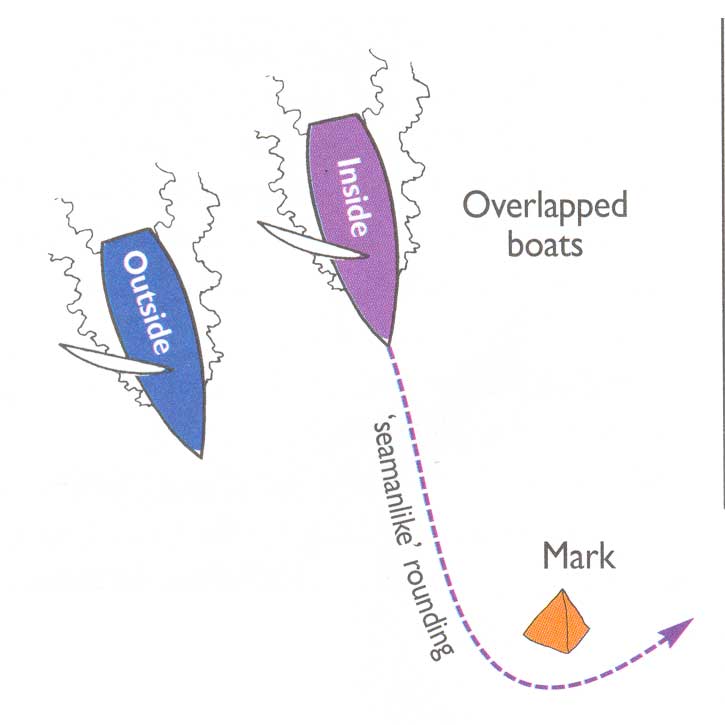 |
| When two overlapped boats are approaching a mark (above) or an obstruction (below), the outside boat must give the inside boat room to round or pass the mark or obstruction. If the outside boat has right of way, the inside boat may take just enough room for a ‘seamanlike” rounding. |
1) The outside boat shall give the inside boat room to round or pass the mark or
obstruction; and
2) If the inside boat has the right of way, the outside boat shall also keep
clear.
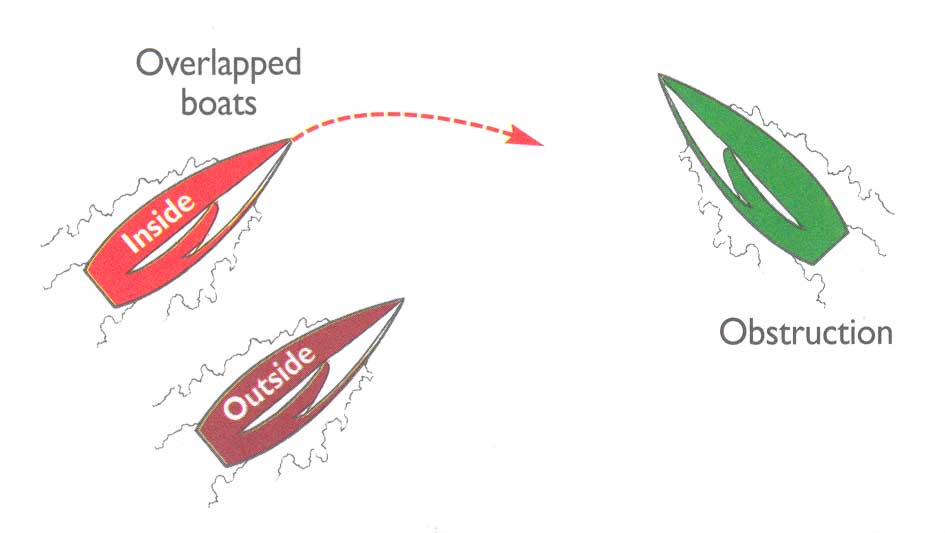 |
| 18.2 Giving Room; Keeping Clear (a) Overlapped - Basic Rule When boats are overlapped the outside boat shall give the inside boat room to round or pass the mark or obstruction, and if the inside boat has right of way the outside boat shall also keep clear. Other parts of rule 18 contain exceptions to this rule. |
When rule 18 turns on, it modifies the definition of “room”. According to ISAF
Case 21, “the word room in rule 18 means the space needed by an inside boat,
which in the existing conditions is handled in a seamanlike way, to round or
pass promptly between the outside boat and the mark or obstruction, including
room to tack or jibe when either is a normal part of the maneuver.”
In other words, an inside boat is entitled, at a minimum, to have enough room to
fit between the outside boat and the mark, including space to tack or jibe as
needed. This is important for an inside boat so she knows how much room she can
take. It’s also critical for an outside boat so she knows how much room she must
give.
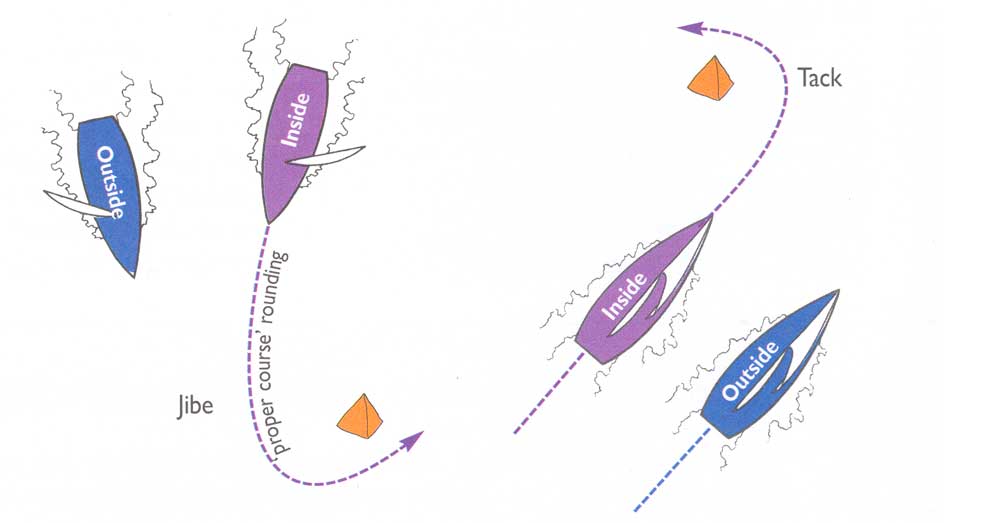 |
| When an inside boat is entitled to room at a mark or obstruction, this includes space for her to jibe (above left) or tack (above right) when either is a normal part of the rounding maneuver. If the inside boat has right of way (above left), the outside boat must keep clear, and the inside boat can take enough room for a ‘proper course’ rounding. |
| Room - In rule 18, room is room for an inside boat to round or pass between an outside boat and a mark or obstruction, including room to tack or gybe when either is a normal part of the maneuver. |
In both cases, room depends a lot on the wind and sea conditions, and the speed
and size of the boats. According to US Appeal 20, “Room is the space a boat
needs to pass the mark in a seamanlike way, not the space she would take to pass
the mark in a tactically desirable manner.”
What does it mean to round a mark “in a seamanlike way”? ISAF Case 21 explains
that this phrase applies to both boats at a mark rounding: “First, it addresses
the outside boat, saying she must provide enough room so the inside boat need
not make extraordinary or abnormal maneuvers to keep clear of her and the mark.
“It also addresses the inside boat. She is not entitled to complain of
insufficient room if she fails to execute with reasonable efficiency the
handling of her helm, sheets and sails...”
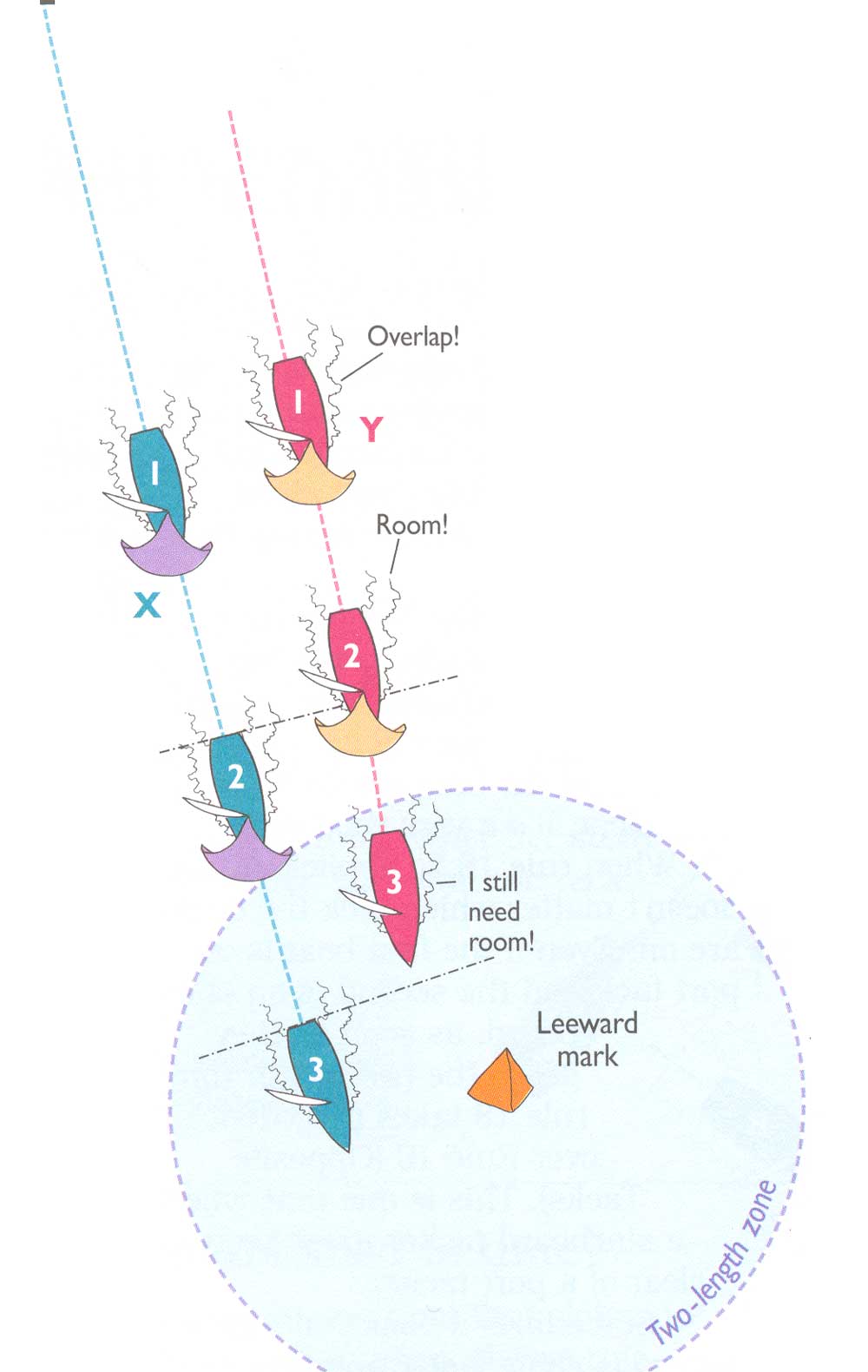 |
| What if the overlap is broken? Rule 18.2(b) describes a very specific situation. It applies only when two boats were overlapped before either of them reached the two-length zone and then that overlap is broken after one of them reaches it. The critical moment is when one of the boats reaches the two-length zone. If they are overlapped at this point, rule 18.2(b) says the outside boat must continue to give room as long as rule 18 applies, even if the overlap is broken before they round the mark. In addition, if the outside boat becomes clear astern or gets an inside overlap, she is not entitled to room and must keep clear. Consider the situation shown here. At position 1, the boats become ‘about to round’ the mark, so rule 18 turns on. Since the boats are overlapped, rule 18.2(a) says the outside boat (X) must give the inside boat (Y) room to round the mark. However, after X enters the zone she pulls clear ahead of Y. Now what happens? Since the boats were overlapped before the zone and the overlap was broken after one of them entered it, rule 18.2(b) applies. It says X must continue to give Y room to round the mark (Y may well catch up again and need room). However, if X gets far enough ahead she may be able to round close to the mark without interfering with Y. If Y pulls clear ahead of X inside the zone, then the situation is different. Now X becomes clear astern, and rule 18.2(b) says she shall keep clear. |
| 18.2 Giving Room; Keeping Clear (b) Overlapped at the Zone If boats were overlapped before either of them reached the two-length zone and the overlap is broken after one of them has reached it, the boat that was on the outside shall continue to give the other boat room. If the outside boat becomes clear astern or overlapped inside the other boat, she is not entitled to room and shall keep clear. |
Of course, any judgment of what is seamanlike or not must take into account the
‘existing conditions.’ These include primarily the wind strength and sea state.
Obviously, a seamanlike rounding in two knots of wind will be different than one
in a 25-knot blow.
According to rule 18.2(a), an inside boat is always entitled to at least enough
room to make a seamanlike rounding in the existing conditions. When she has the
right of way, however, the outside boat must also keep clear of her. This means
the inside boat can take as much room as she needs for her ideal rounding, and
the outside boat must stay out of her way.
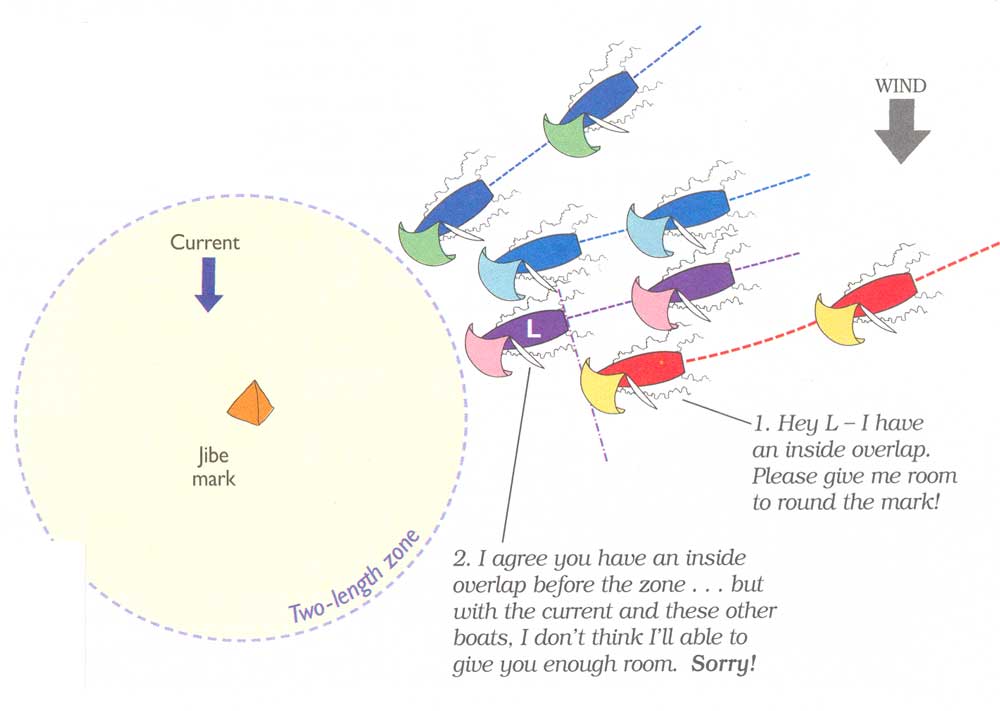 |
| “Unable to give room” The last sentence of rule 18.2(e) may be stating the obvious, but it expresses a very important concept. It says that when an overlap begins, the inside boat is not entitled to room unless the outside boat can physically give her enough room at the mark. When rule 18 turns on (which is usually after the boats become “about to round or pass” a mark or obstruction), an outside boat must do everything possible to provide room as required. However, she does not have to anticipate that another boat may get an inside overlap. In other words, a boat that will be on the outside doesn’t have to begin making room until an overlap is actually established. If at that point she is unable to give room, rule 18 does not require her to do so. |
| Rule 18.2(e) Overlap Rights ...If the outside boat is unable to give room when an overlap begins, rules 18.2(a) and 18.2(b) do not apply. |
However, rule 18 has one major limitation on the amount of room that a
right-of-way inside boat can take at a mark. If she has to jibe to sail her
proper course around the mark, she may sail no farther from the mark than needed
to sail that proper course.
Remember that rule 18.2(a) applies only to boats that are overlapped as they
approach and round a mark or obstruction. When they are not overlapped, rules
18.2(b), 18.2(c) and/or 18.5 apply instead.
When boats are overlapped rule 18.2(a) applies at almost every mark or
obstruction, including other racing boats. However, it does not apply when:
• the boats are approaching a starting mark to start (and therefore the windward
boat is barging);
• the outside boat is unable to give room when the overlap begins; or
• one boat tacked inside the two-length zone and is subject to rule 18.3
(Tacking at a Mark).
Dave publishes the newsletter Speed & Smarts. For a subscription call:
800-356-2200 or go to:
www.speedandsmarts.com